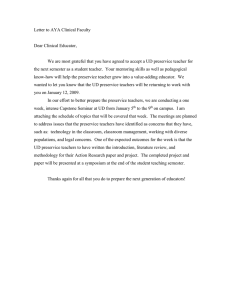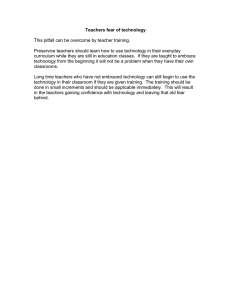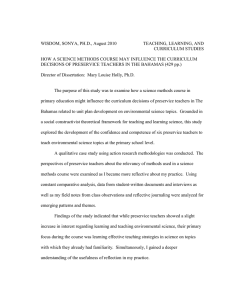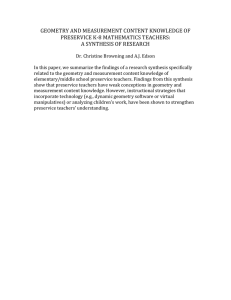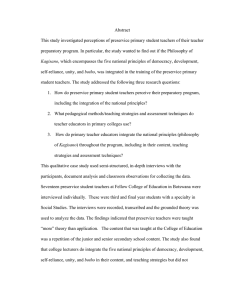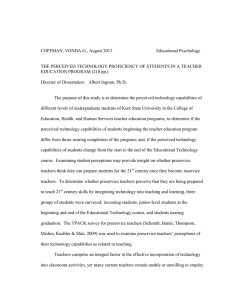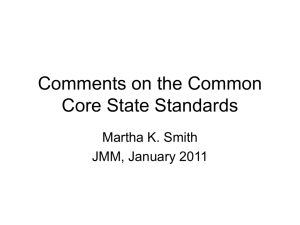determining and evaluating ideal physics teacher`s
advertisement
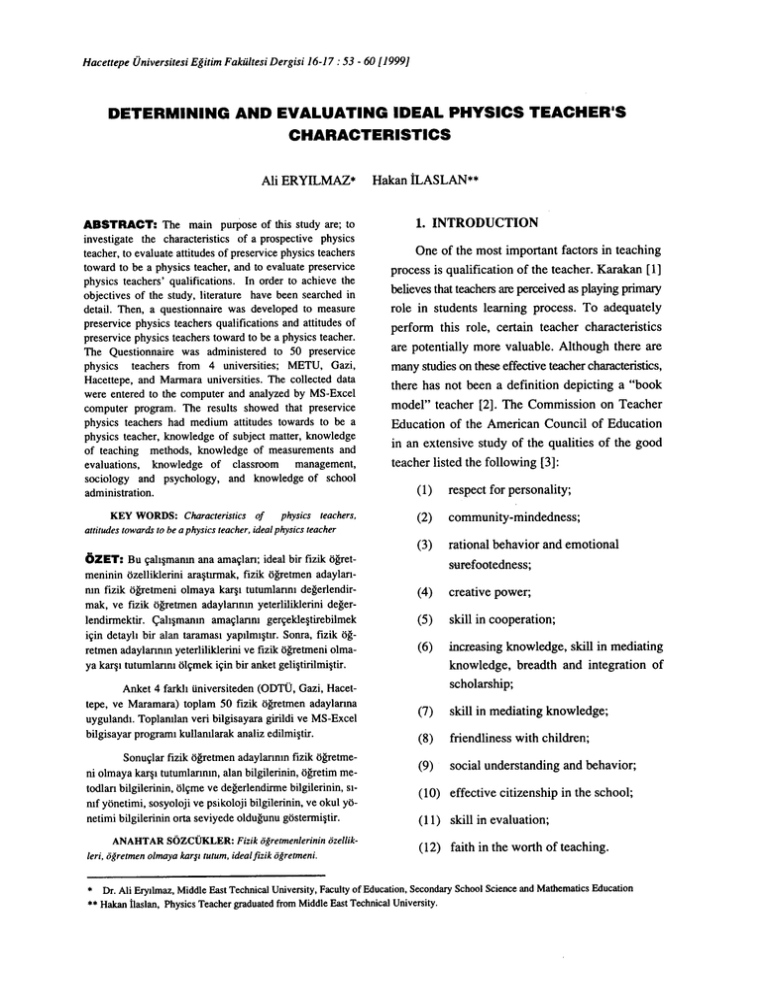
Hacettepe Üniversitesi Eğitim Fakültesi Dergisi 16-17 : 53 - 60 [1999J DETERMINING AND EVALUATING IDEAL PHYSICS TEACHER'S CHARACTERI5TICS Ali ERYILMAZ* ABSTRACT: The main purpose of this studyare; to investigate the characteristics of a prospective physics teacher, to evaluate attitudesof preservice physics teachers toward to be a physics teacher, and to evaluate preservice physics teachers' qualifications. In order to achieve the objectives of the study, literature have been searched in detail. Then, a questionnaire was developed to measure preservice physics teachers qualifications and attimdes of preservice physics teachers toward to be a physics teacher. The Questionnaire was administered to 50 preservice physics teachers from 4 universities; METU, Gazi, Hacettepe, and Marmara universities. The collected data were entered to the computer and analyzed by MS-Excel computer program. The results showed that preservice physics teachers had medium attitudes towards to be a physics teacher, knowledge of subject matter, knowledge of teaching methods, knowledge of measurements and evaluations, knowledge of classroom management, sociology and psychology, and knowledge of school administration. KEY WORDS: Characteristics of physics teachers, attitudestowards to be a physics teacher, ideal physics teacher ÖZET: Bu çalışmanın ana amaçlan; ideal bir fizik öğretmeninin özelliklerini araştırmak, fizik öğretmen adaylannm fizik öğretmeni olmaya karşı tutumlannı değerlendirmak, ve fizik öğretmen adaylannm yeterliliklerini değerlendirmektir. Çalışmanm amaçlannı gerçekleştirebilmek için detaylı bir alan taraması yapılmıştır. Sonra, fizik öğretmen adaylannm yeterliliklerini ve fizik öğretmeniolmaya karşı tutumlannı ölçmek için bir anket geliştirilmiştir. Anket 4 farklı üniversiteden (ODTÜ, Gazi, Hacettepe, ve Maramara) toplam 50 fizik öğretmen adaylanna uygulandı. Toplanılan veri bilgisayara girildi ve MS-Excel bilgisayar programı kullanılarak analiz edilmiştir. Sonuçlar fizik öğretmen adaylannm fizik öğretmeni olmaya karşı tutumlannın,alan bilgilerinin, öğretim metodlan bilgilerinin, ölçme ve değerlendirmebilgilerinin, sınıf yönetimi, sosyoloji ve psikoloji bilgilerinin, ve okul yönetimi bilgilerinin orta seviyede olduğunugöstermiştir. ANAHTAR SÖZCÜKLER: Fizik öğretmenlerinin özellik- leri, öğretmen olmaya karşı tutum, ideal fizik öğretmeni. * ** Hakan İLASLAN** ı. INTRODUCTION One of the most important factors in teaching process is qualification of the teacher. Karakan [1] believes thatteachersare perceived as playing primary role in students learning process. To adequately perform this role, certain teacher characteristics are potentially more valuable. Although there are many studieson these effective teachercharacteristics, there has not been a definition depicting a "book model" teacher [2]. The Commission on Teacher Education of the American Council of Education in an extensive study of the qualities of the good teacher listed the following [3]; (1) respect for personality; (2) community-mindedness; (3) rational behavior and emotional surefootedness; (4) creative power; (5) skill in cooperation; (6) increasing knowledge, skill in mediating knowledge, breadth and integration of scholarship; (7) skill in mediating knowledge; (8) friendliness with children; (9) social understanding and behavior; (LO) effective citizenship in the school; (ll) skill in evaluation; (l2) faith in the worth ofteaching. Dr. Ali Eryılmaz, Middle East Technical University, Faculty of Education, Secondary School Science and Mathematics Education Hakan İlaslan, Physics Teacher graduated from Middle East Technica! University. 54 Ali Eryılmaz. J. of [Ed. 16-17 Hakan İlaslan Possibly the most significant data can be conceming pupil judgments of what qualities are importantin the good teacher [3]. A study attemptedto (23) good voice; (24) knows ability of class; find out what high school students regarded as the good qualities of teacher. Twenty-eight teachers in a high school were ranked by their students, and the qualities they considered good and bad in teachers were listed. Thirty-three items were mentioned twenty times or more. These are listed below in descending order of mention: (25) able to give good advice; (26) appreciates whatever weaknesses pupils may possess; (27) uses good English; (28) supervises study, and allows study periods; (1) good dispüsition,kindness,andpatience; (29) understands home conditions; (2) impartiality; (30) gives ferquent tests; (3) ability to explain clearly; (31) ventilates room; (4) dicipline; (32) dresses conservatively; (5) knowledge of subject; (33) and cooperates. (6) faimess in marking; (7) sense of humor; (8) helps pupil out of class; (9) understands high school students; (10) knows how to interest pupils; (1) cooperative democratic attitude; (11) honest, and keeps his word; (2) kindlines and patience; (12) good judgement; (3) wide variety of interests; (13) good personality; (4) good appereance and pleasing manner; (14) school spirit; (5) faimess and impartiality; (15) elear and definite in assigments; (6) sense of humor; (16) distinguishes important and unimportant; (7) good disposition; (17) will-power; (8) interest in pupil's problems; (18) leadership; (9) flexibility; (19) never laughs at pupils mistakes; (10) use ofrecognition and praise; (20) makes no use of detention rooms; (11) superior teaching efficiency. (21) general knowledge as well as of her subject; (22) does not get off subject; Another study of interest in this connection is that which was made in 1947 by Witty. From nearly 12000 letters written by children on "The Teacher Who Helped Me Most" the following traits are listed in descending order of mention (cf., [3]): Bossing [3], in collaboration with a graduate student, has carried on an extended research to discover, significant traits of good secondary teachers. This study was made by comparing the 1999 ] 55 Determining and Evaiuating Ideal Physics Teacher's Characteristics judgments of school superintendents and principals as to those qualities they deemed important for teachers to possess as theyanalyzed their own teachers. These judgments were then checked against data from the Appointment Bureau and the University Registrar's office records to discover other factors of value, particularly of a predictive nature. The study which involved data covering several years, yielded the following teacher traits or qualities that appear significant: (1) dicipline, (2) teaching skill, (3) care of routine, (4) use of English, (5) tact, (6) adaptability, (7) sense of justice, (8) cooperation, (9) optimism, (10) school management, (11) promptness and regularity, (12) self-control, (13) initiative and self-reliance, (14) attention to individual needs, (15) skill in motivating work, (16) health, (17) resourcefulness, (18) voice, (19) enthusiasm. (1) preparation in the science that includes depth as well as breath, (2) competencies in performing certain skills needed for a variety of classroom teaching leaming modes, (3) competencies ın the psychological, sociological historical foundations of education, (4) flexibility in personal style that permits coping with change, (5) variety of experience with people all ages paralleIing experiences needing to greater scientific proficiency, (6) experience with the creative aspects of science and some specific analysis of the meaning of such experience, (7) an understanding of the philosophy and history of science and experience with the interaction of science and society. McDermott [5] declares the needs of high school physics teachers as follows: (1) Physics teachers should understand elementary physics in depth. (2) Physics teachers should examine origins of knowledge of physics. (3) Physics teachers should expenence laboratory centred leaming There is aremarka ble similarity in the findings of all those studies as to composite traits or qualities that make up the picture of the successful teacher. In their artiele, Lunetta, Yager and Sharp [4] describe the characteristics of science teacher as follows: . (4) Physics teachers should acquire a sense of the unity of physics. (5) Physics teachers should relate physics to the real world. (6) Physics teachers should see physics as part of the real world. (7) Physics teachers should become familiar with good programs. (8) Physics teachers should apply leaming theory to teachingo (9) Physics teachers should develop skills for inquiry in science. 56 Ali Eryılmaz. The other dimension of preparing physics teachers is the courses included in the physics education curriculum. The distinction between a researcher in physics (physicist) and physics teacher must be emphasized in different curriculum they follow. There are some extra courses which contain some subjects that may not be necessary for high school physics teachers. Such courses like Quantum Mechanies, Differential Equations and Electromagnetic Theory are considered to be very complex and challenging for a high school physics teacher. In aresearch report prepared by the Comission on College Physics in the USA, it is expressed that "the teacher' s needs are different. from those of the professional physicisİ. He does not need to leam to do quantum mechanical calculations or the mathematics of general relavity" [6]. These characteristics should be more detailed and research-based. That is why this study is undertaken. Turkish education system has some problems for years. One of them is "How to Educate Prospective Teachers". Although there are some studies in Turkey [1, 10, 11], they do not fully cover all the aspects. The purposes of this studyare: ı. In the Ministry of Education presses [8,9], to be an ideal teacher you should; ll. to evaluate attitudes of preservice physics teachers toward to be a physics teacher, lll. and to evaluate preservice teachers' qualifications. teaching mission. * * managementand administrationmission. * supervisor mission. · 5. know how to manage teacher-student relations. 6. know school process and society mission. * school rules. * good relations with other teacher. * join the school activities. steps were The problem and objectives of the study were clearly stated. · The joumals and theses in the libraries of METU, Ankara and Gazi Universities were searched to find related studies. · A questionnaire was developed to measure preservice physics teachers qualifications and attitudes of preservice physics teachers toward to be a physics teacher. · 3. know teaching and teaching methods. 4. know measurements and evaIuating to teached contents. METHODOLOGY In this study, the following undertaken to reach the purpose; good subject-matter knowledge. 2. know daily, yearly and lesson planning. physics 2.1. Procedure 1. know teacher missions. * to investigate the characteristics of an ideal physics teacher, 2. According to XI. National Education Commission (Milli Eğitim Şurası) decisions [7], curriculum that educating high school teachers should contains 64.6% subject-matter courses, 10.4% general culture courses, 25% education courses. J. of [Ed. 16-17 Hakan İlaslan · The Questionnaire was administered to 50 preservice physics teachers. Finally, the collected data were entered to the computer and analyzed by MS-Excel computer program. 2.2. Measuring Tools A questionnaire was developed to measure preservice physics teachers' qualifications and attitudes of preservice physics teacher toward to 1999 ] 57 Determining and Evaiuating Ideal Physics Teacher's Characteristics be a physics teacher. The questionnaire has nine parts. The first part is related to personal information. The second part contains a question First preferences of the preservice physics teachers in the University Entrance Examination (VEE) were accumulating in the engineering "What are the five elements that prevent you being a qualified physics teacher". Other seven parts have 92 Likert type items. A samp1e item from each part is given in the appendix. The seven parts and number of the questions in each part are faculty. 64% of them chose the engineering faculties, 26% of them chose medical science and 10% of the preservice physics teachers chose science faculties. What a pitty that none of the participants chose the education facu1ties as a first preference in the VEE. as follows: · attitudes toward to be a physics teacher (20 items) · · knowledge of subject-matter (8 items) knowledge of teaching methods (9 items) · While 54% of the preservice physics te- achers were graduated from science department of the high school s, 40% of them were graduated from mathematics, and 6% of them were graduated from vocational schools. knowledge of measurementsand evaluations (12 items) · knowledge of classroom management, sociology and psychology (6 items) · · knowledge items) of school administration (8 teacher characteristics (29 items) 2.3. Subjects The subjects of this study were 50 preservice physics teachers from four universities (30 from METU,5 from Gazi University, 7 from Hacettepe University, 8 from Marmara University). Birth dates of the preservice physics teachers range between 1973 and 1976. 40% of them are bom in 1976,22% 3. RESULTS 3.1. Faetors that Prevent Preserviee Physies Teaehers from Being a Qualified Physies Teaeher In this part, the thinking of the preservice physics teachers about problems that prevent their qualifications during their education were studied. There are basically seven different answers to the question; · · of them are bom in 1975,28% of them are bom in 1975 and 10% of them are bom in 1973. · 56% of the samp1e are maIe, 44% of them are female. The University Entrance Examination scores of the preservice physics teachers in this studyare between 440 and 530. · 84 % of the preservice physics teachers agree that they take an ineffective and short practice teaching course. 70 % of the preservice physics teachers believe that they have been educated as a physicist and there are advanced physics courses in the curricula. 68 % of the preservice physics teachers say that their physics courses related with high school physics contents are not enough in number. 20% of their scores are from 450 to 475. 50% of 52 % of the preservice physics teachers claim that there is not enough laboratory courses related high school physics contents their scores are from 476 to 499. FinaIly, 22% of their scores are between 500 and 530. and given laboratory courses are too complex to apply in Turkish High Schools. 8% of their scores are between 440 and 449. 58 Ali Eryılmaz. · · · 44 % of the preservice physics teachers believe that they leam the concepts by memorizing and theoretically. So they do not know relations of physics with daily life. 30 % of the preservice physics teachers believe that theyare troubled about their future, because their jobs do not give trust. 26 % of the preservice physics teachers say that they did not want to be in education faculties. knowledge of teaching methods, knowledge of measurement and evaluation, knowledge of classroom management, sociology and psychology, knowledge of school administration, and teacher characteristics. Table 1. Mean, StandardDeviation, Maximum, and Minimum Scores of All Variables Tl T2 3.2. Attitudes Toward to be a Physies Teaeher Mean, and standard deviation of preservice physics teachers' attitudes toward to be a physics teacher are given in Table ı. The first number in the parenthesis indicates that there are 20 items to measure preservice physics teachers' attitudes and the possible minimum score is 20. The second number in the paranthesis indicates that the possible maximum score is i 00. The preservice physics teachers' mean on the attitude İtems is 46.36 over 100. This could be normal for students from other faculties but this is too low for preservice physics teachers. Theyare prospective physics teachers but they have very low attİtudes to be a physics teacher. 3.3. Qualifieations of Preservice Physics Teaehers Table 1 shows the mean, standard deviation, maximum, and minimum scores of all variables. The first numbers in the parentheses indicate the number of the questions to measure that variable and the possible minimum score on that variable. The second numbers in the parentheses indicate the possible maximum score on that variable. The preservice physics teachers have above average scores on knowledge of subject matter, J. of [Ed. 16-17 Hakan İlaslan T3 T4 T5 T6 Parts of the Scale AUitudestoward to be a physics teacher (20- i(0) Knowledge of subject maUer (8-40) Knowledge of teaching methods (9-45) Knowledge of Measurementand Eva1uation(12-60) Knowledge of classroom management, sociology and psychology (6-30) Knowledge of Mean SD Max Min 46.36 10.66 81 33 30.64 4.58 38 21 31.64 3.99 40 22 45.54 5.60 57 35 22.26 3.35 30 16 24.38 4.90 35 15 112.1 15.95 137 68 school administration T7 (8-40) Teacher characteristics (29-145) Table 2 shows the correlation coefficients among the variables. Statistically significant correlation coefficients are marked with asterisks. For example, teacher characteristics variable is not correlated with attitudes toward to be a physics teacher and knowledge of school administration variables. However, as expected it is correlated with knowledge of subject matter, knowledge of teaching methods, knowledge of measurement and evaluatİon, and knowledge of school admİnİstratİon. 1999 ] Determining and Evaluating Ideal Physics Teacher's Characteristics Table 2. Correlation Coefficients Among the Variables directed in practical ways and every day examples of phenomena Tl T2 T4 T3 T5 T6 Tl T2 -0.21 T3 0.16 0.37* T4 O.LL 0.39* 0.67* T5 0.33* 0.23 0.24 0.16 T6 0.31* 0.24 0.39* 0.36* 0.50* T7 0.02 0.53* 0.33* 0.41 * 0.48* 0.21 * p ~ 0.05 4. DISCUSSION AND CONCLUSIONS The responses of the preservice physics teachers show that they have great problems. Main result of this study is that most of the preservice physics teachers do not ready to take mission in the high schools. According to results of the questionnaire most of the preservice physics teachers will be graduated below the ideal standards. All of the preservice physics teachers take physics courses related by the high school physics contents in first two years of the their university education. This affects them negatively. While theyare studying advanced physics courses, they forget the details of the freshman physics. First year introductory physics courses are admittedly insufficient for teaching a high school physics course. However, it does not follow that advanced physics courses provide useful preparation for preservice physics teachers. Although work beyond the introductory level may help preservice physics teachers deepe:1 their understanding of physics, no guidance is provided about how to make appropriate use of this teaching students. knowledge in Major concem İn the preservİce physİcs teachers' knowledge, developments should be 59 -being taught. Preservice physics teachers have conceptual difficulties. it has large effect on their achievement in physics. So, laboratory is an important factor affecting training of preservice physics teachers. Working thorough parts of PSSC is a great deal more valuable than merely reading about these programs. Teaching courses in the university programs are not effective. Most of the preservice teachers do not be readyto teach physics after taking those courseS.For example, they do not know how teaching methods can be used effectively or what should be done in problem situations in the class. Especially, practice teaching courses are insufficient. Less time, negative attitudes of some guide teachers and lots of taken courses in the last semester are some of the reasons of the problem. The teaching courses also do not give any thing about school administration and management to the preservice physics teachers. Another important result is that none of the preservice physics teachers chose the education faculties as the first preference in the UEE and their attitudes toward to be a physics teacher is too low. This problem is probably more important than the previous one, because even if they have the ideal teacher's characteristics, they do not have positive attitude to use that knowledge. 5. SUGGESTIONS In the light of the findings, it is clear that the physics education curriculum in the universities should be improved. Future physics teachers need to know basic physics subject very well but it is evident that most of them loose their interest about those subjects during their hard education. The content of the physics courses in B.Sc. programs should be modified and be parallel to that of high school physics courses to get higher efficiency. To promote conceptual understanding of preservice physics teachers, introductoryphysics J. of [Ed. 16-17 Ali Eryılmaz. Hakan ilaslan 60 laboratories should be improved. Preservice physics teachers should have a chance to discover the advantages of learning by active partidpation. To make the relations of physics with real and daily life, some extra courses should be added to the curriculum like history of science, ecology and environment, or astronomy. To prepare the preservice physics teachers better for the active schoollife, they should spend more time in high schools during their education and preservice teachers should have more active roles during their practice teaching in different area like school management. We have to find a way to improve preservice physics teachers aUitudes toward to be a physics teacher. The suggestions above would help to this purpose. In addition to these, the instructors in the university educate the preservice teachers. That is why, they should be a model teacher in the first place. The instrnctors should have the ideal teacher characters and high attitudes, and then show these to the preservice teachers. Appendix: Sample Questions from the Scale Parts of the Scale A Sample Item Tl T5 T7 T2 T3 T4 T6 Agree Neutral Disagree Strongly Disagree Excellent Good Normal Bad Very Bad My ideal job was to be a teacher i can establish discipline in the classroom i do believe as a physics teacher candidate that i have eager to teach. How is your knowledge about mechanics? How is your knowledge about the content and usage of cooperatiye leaming? How is your knowledge about preparationof multiple choice test items? i know the regulations and rules of schools. REFERENCES 1. Strongly Agree Karakan, A.G. "Öğrenci ve Öğretmen AIgılamalanna Göre Ankara'daki Liselerde Fizik Öğretiminin Sorunlannın Tespit Edilmesi." Unpublished Master Thesis, Gazi Ünv. Eğitim Fak. Ankara (1991). 6. McDermott, L.C. "A perspectiye on Teacher Preparationin Physics and Other Science." American Journal ofPhysics, 50:.734-742, (1990). 7. XI. Milli Eğitim Ankara (1982). 8. Milli Eğitimi Geliştirme Projesi "Her Yönüyle Öğretmen Olabilme" Milli Eğitim Basımevi, Ankara (1996). 9. Milli Eğitim Bakanlığı Tebliğler Dergisi, 2359: 315-319 (1992). Şurası, M.E.G.S.B. Yayınlan, 2. Travers, D.P. & Rebore, R.W. Foundation of Education. Third Edition. Allyn andBocon Company, Boston (1995). 3. Bossing, N.L Teaehing in the seeondary sehools. Third Edition. H.Mifflin Company. Boston, (1952). 4. Lunetta, V.N., Yager, R.E., & Sharp, WL "Needed: New Models for Science Teacher Education." Scienee Education, 58(4): 497-503 (1974). 10. Doruk, H. "A Case Study on Evaluating the Content-Based Competeney Preservice Physics Teachers" Unpublished Master Thesis, METU, Faculty of Education, Ankara, (1992). 5. McDermott, L.C."lmproving High School Physics Teachers Preparation". The Physies Teaeher, 13: 523-529, (1975). lL. Gerger, Y. "Öğretmen Yetiştirmenin Planlanması". Unpublished Master Thesis, Ankara Ünv. S.B.E. Ankara, (1986).
